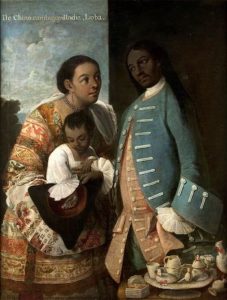
De Chino cambujo e India, Loba
*On this date in 1600, we affirm Lobo (the word). Lobo is a racial categorical term from the Spanish colonial era in the Americas.
It refers to mixed-race lineage, far down the racial hierarchy the Spanish colonial regime created. Lobo and coyote are derogatory names for persons of mixed race, referred to by animal names. It could include persons of African and Indian ancestry and many related variations. Lobo does not have a fixed meaning, with possible parents being a Black and Indian woman; Cambujo (African/Amerindian) and Indian woman; Torna atrás and Indian woman; Mestizo Indian woman; Salta atrás (of African/European ancestry) and Mulatto woman.
Lobo was a classification used in official colonial documentation, including the Inquisition trials, marriage registers, and censuses. One instance of a Loba is a mixed-race woman who came before the Mexican Inquisition; she had multiple racial labels. She was publicly known as a China and was a parda or pardo (a brown-skinned person) who "looked like a loba," suggesting she had visible African features.
Lobos were known to be enslaved persons in seventeenth-century Mexico, likely with the mother being a Negra. The status of a slave or free child followed that of the mother, so children born to enslaved mothers were born into slavery, regardless of their paternity. In historian Ben Vinson III's analysis of what he calls "extreme racial categories," he includes Lobos with castizos, moriscos, albinos (persons with mixed African ancestry who look European), coyotes, "mestindios," and chinos.
There were regional differences in colonial Mexico for racial labeling. For instance, in Xichú and Casas Viejas in the Bajío region near Querétaro and the Sierra Gorda mountains, there were resident indigenous populations and blacks and mulattos, locally the people used Lobos as a "normative category." In his study of marriage patterns from marital registers, Vinson found no records of Lobos marrying each other; brides and grooms thus classified chose partners from other racial categories.
In eighteenth-century casta paintings, Lobos are usually shown doing physical work and not lavishly dressed, indicating lower-class status. In Joaquín Antonio de Basarás’s Origen, costumbres, y estado presente de Mexicanos y Philipinos (1763), the lobo father is a water carrier, while his Indian wife sells chickens. An early 18th-century set of casta paintings shows the Lobo as the offspring of a Black father and Indian mother. In another, a Lobo father and an Indian mother have a dark-skinned child labeled a Lobo Torna atrás, meaning the child more closely resembles the Black father.